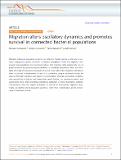| dc.contributor.author | Ranjan, Tanvi | |
| dc.contributor.author | Gokhale, Shreyas Shashank | |
| dc.contributor.author | Conwill, Arolyn Macdonald | |
| dc.contributor.author | Gore, Jeff | |
| dc.date.accessioned | 2019-03-12T20:06:43Z | |
| dc.date.available | 2019-03-12T20:06:43Z | |
| dc.date.issued | 2018-12 | |
| dc.date.submitted | 2018-05 | |
| dc.identifier.issn | 2041-1723 | |
| dc.identifier.uri | http://hdl.handle.net/1721.1/120940 | |
| dc.description.abstract | Migration influences population dynamics on networks, thereby playing a vital role in scenarios ranging from species extinction to epidemic propagation. While low migration rates prevent local populations from becoming extinct, high migration rates enhance the risk of global extinction by synchronizing the dynamics of connected populations. Here, we investigate this trade-off using two mutualistic strains of E. coli that exhibit population oscillations when co-cultured. In experiments, as well as in simulations using a mechanistic model, we observe that high migration rates lead to synchronization whereas intermediate migration rates perturb the oscillations and change their period. Further, our simulations predict, and experiments show, that connected populations subjected to more challenging antibiotic concentrations have the highest probability of survival at intermediate migration rates. Finally, we identify altered population dynamics, rather than recolonization, as the primary cause of extended survival. | en_US |
| dc.description.sponsorship | National Institutes of Health (U.S.) (Grant R01 GM102311-01) | en_US |
| dc.description.sponsorship | National Science Foundation (Award PHY-1055154) | en_US |
| dc.description.sponsorship | National Institutes of Health (U.S.) (Award GM085279-02) | en_US |
| dc.description.sponsorship | Alfred P. Sloan Foundation (Award BR2011-066) | en_US |
| dc.description.sponsorship | National Institutes of Health (U.S.) (Award DP2) | en_US |
| dc.publisher | Nature Publishing Group | en_US |
| dc.relation.isversionof | http://dx.doi.org/10.1038/s41467-018-07703-y | en_US |
| dc.rights | Creative Commons Attribution 4.0 International license | en_US |
| dc.rights.uri | https://creativecommons.org/licenses/by/4.0/ | en_US |
| dc.source | Nature | en_US |
| dc.title | Migration alters oscillatory dynamics and promotes survival in connected bacterial populations | en_US |
| dc.type | Article | en_US |
| dc.identifier.citation | Gokhale, Shreyas et al. “Migration Alters Oscillatory Dynamics and Promotes Survival in Connected Bacterial Populations.” Nature Communications 9, 1 (December 2018): 5273 © 2018 The Author(s) | en_US |
| dc.contributor.department | Massachusetts Institute of Technology. Department of Physics | en_US |
| dc.contributor.mitauthor | Gokhale, Shreyas Shashank | |
| dc.contributor.mitauthor | Conwill, Arolyn Macdonald | |
| dc.contributor.mitauthor | Gore, Jeff | |
| dc.relation.journal | Nature Communications | en_US |
| dc.eprint.version | Final published version | en_US |
| dc.type.uri | http://purl.org/eprint/type/JournalArticle | en_US |
| eprint.status | http://purl.org/eprint/status/PeerReviewed | en_US |
| dc.date.updated | 2019-03-04T14:45:03Z | |
| dspace.orderedauthors | Gokhale, Shreyas; Conwill, Arolyn; Ranjan, Tanvi; Gore, Jeff | en_US |
| dspace.embargo.terms | N | en_US |
| dc.identifier.orcid | https://orcid.org/0000-0002-6052-0345 | |
| dc.identifier.orcid | https://orcid.org/0000-0003-4583-8555 | |
| mit.license | PUBLISHER_CC | en_US |
